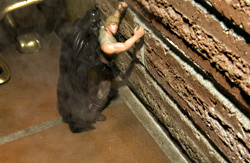The son of a Gig Harbor attorney, Howard Hunt graduated from the University of Washington with a degree in political science. On a recent morning, Hunt, now 41 and a hardened alcoholic, leans on a walker in the dining room at the taxpayer-subsidized 1811 Eastlake residence, which represents a controversial approach to grappling with Seattle’s chronic public inebriates. Here, guys like Hunt are selected to move into the blue-and-silver building a stone’s throw from Interstate 5 because of their fiscal burden on the public purse—and are permitted to drink to their heart’s content.
Hunt’s poison of choice is whisky—specifically, Broker’s Reserve, $10 a bottle at the state liquor store downtown. Also, he has a week’s worth of stubble on his face and wears a purple B.U.M. Equipment sweatshirt. He has just gotten out of the King County Jail after cooling his heels for five days over violating a no-trespassing order at Metro bus stops for drunken behavior.
“I don’t want to drink myself to death, but I’m well on the path to it,” says Hunt, who once waited tables at the Brooklyn on Second Avenue before being fired for showing up drunk to work one too many times. Last fall, he was struck by a car on Aurora—that’s the reason for the aforementioned walker. “I don’t buy into this inherited alcohol syndrome thing because no one makes me drink. But I cannot stop.”
Well before 1811 opened this past December, it was attacked in the press with dry-drunk ferocity. The project was characterized as immoral—described as a veritable fraternity house for street drunks, where longtime tipplers get low-cost apartments and party themselves into oblivion. Bill O’Reilly berated the place on national television, while locally, KOMO-TV’s Ken Schram and the Seattle Post-Intelligencer‘s Robert Jamieson growled about how 1811 enabled drunks and violated the precepts of sobriety and chemical dependency recovery.
Street drunks in America’s urban centers have long generated headaches and temperance talk, yet none of the solutions for dealing with them—jail, psychiatric treatment, enforced sobriety—has stemmed the tide. Estimates vary, but in Seattle it’s generally accepted that there are about 500 chronic public inebriates on the streets on any given day. Some of them chew up upward of $50,000 a year apiece in tax dollars as they cycle from the streets to jail to the emergency room to the sobering center and back to the streets, according to a recent study.
Wouldn’t it be cheaper to stick these frequent fliers in permanent housing and let them drink? Would drunks drink less if they had permanent shelter as opposed to a shit-stained blanket under a Broadway awning? Those are the questions at the core of 1811, which is operated by the Downtown Emergency Services Center, brought to the fore by harm reduction advocates (the folks who gave the world needle exchange programs). To this end, 1811 is a national trailblazer, the nation’s only program devoted to addressing homeless drinking with small apartments, gentle case management, and a hands-off approach to High Life Tallboys and fifths of Beam. Building manager Margaret King says that caseworkers regularly talk to 1811 residents about the relationship between booze and their own flagging health. By DESC estimates, it costs about $13,000 per year to put a person up at the residence.
“There is a myth that we have hostility to sobriety in this program,” says King. “That’s a crock.”
One resident, who requested anonymity, showed off his studio apartment on the fourth floor of the building. After 21 years on the streets, he’d gone to a thrift shop and run wild, buying half a dozen cheap stereo speakers. There’s a poster of the rapper Nelly on one wall, and out the window you can see the Space Needle and the new condo villages of South Lake Union. He says he’s proud of his home, right down to the opened can of tuna sitting on the kitchen counter. In his trash can are about a half-dozen empty cans of Steel Reserve malt liquor, likely proffered from a convenience store on nearby Stewart Street—an acquisition that may prove difficult once the state Liquor Control Board’s sweeping new ban on package sales of malt liquor and fortified wine in the city hits in November.
The lobby of 1811 is airy, the walls covered with donated Asian and Native American prints, the linoleum floors colored sage and brown. Adjacent to that area is a dining room where residents get breakfast and dinner (they are on their own for lunch). There’s a TV room with a big screen down the hall.
Most of the time, 1811 is quieter than your average college dorm. Other homeless shelters in town, such as the one at the Morrison Hotel, are far noisier and seem like free-floating psych wards. But at 1811, residents usually hole up in their rooms or, if they are medically frail, in the downstairs cubicles where they have a bed, a wardrobe, and a small refrigerator. Otherwise, they are out in the summer sun, visiting friends, meeting with a social worker elsewhere in town or attending an AA meeting.
One of the residents is a dwarf, currently sober. One is a man who sometimes sits in the lobby in a wheelchair, insisting that he’s about to die. All told, there are 75 residents: 70 men and five women. Thirty percent are Native American, 20 percent are military veterans, and the average age is 47. Some have nicknames like “Hangover” and “Old School.”
There have been 148 responses by the Seattle Fire Department to 1811 since December, all of them for medical assistance. About 80 percent of these calls happen and at night, says King, when the facility is without a nurse on staff (there’s one on duty from early morning until 5 p.m.). Typically, she says, the calls occur because one of the residents is trying to go dry and runs into the kind of detox shakes that can lead to seizures. Six residents have died since the place opened last December, the majority succumbing to these seizures in their sleep (one of the six died three weeks after being kicked out of 1811 for fighting). The mortality rate has earned 1811 a new name on the streets to go with the “wet house” moniker hung on it by the press: death house.
“I’ve got to keep myself off that list,” says Rex Andrews, 76, referring to the death tally. “My odds are better here.”
The surprising thing to King is how many residents actually try to stop drinking: 60 percent, by her count. Most only make it a few days. Either way, it will likely be well into 2007 before UW researchers can say whether 1811’s first year drove down the cost of care for its 75 residents and whether the drunks drank less than before. But it’s worth a shot, believes Bill Hobson, DESC’s executive director, who says that only 5 percent of chronic inebriates get clean and sober through conventional alcohol treatment. Emblematic of this is Hunt, who, after one 60-day stretch at a local detox facility several years ago, took a bus downtown and “was drunk 10 minutes after I got off,” he says.
Beyond residents’ anecdotal claims that they drink less at 1811—Hunt swears he only downs one fifth of Broker’s per day compared to his high-water mark of two—there are some who make it. In recent months, three residents have moved on to sober housing. Two others tried and failed, and are now back on the streets. One current resident is clean and working concessions at both Safeco and Qwest Fields.
On a recent morning, King responded to a report that one of her elderly residents was wandering around Lower Queen Anne with no idea where he was headed. She found him sitting in a chair in front of an insurance office on Queen Anne Avenue in a dark blue jacket, while two office workers fed him some hooch. Jocular as he piled into the backseat of King’s Subaru, the man spoke of how the sun had awakened him in his apartment at 6 a.m.—and that it was too beautiful a morning not to go for a walk.








